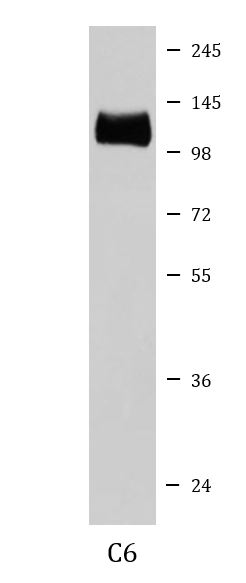anti-ApoER2 antibody
CAT.NO. : ARG41834
US$ Please choose
US$ Please choose
Size:
Trail, Bulk size or Custom requests Please contact us
*产品价格可能会有所调整,请以品牌方官网实时更新的价格为准,以确保准确性。
概述
| 产品描述 | Rabbit Polyclonal antibody recognizes ApoER2 |
|---|---|
| 反应物种 | Hu, Ms, Rat |
| 应用 | IP, WB |
| 宿主 | Rabbit |
| 克隆 | Polyclonal |
| 同位型 | IgG |
| 靶点名称 | ApoER2 |
| 抗原物种 | Human |
| 抗原 | Synthetic peptide of Human ApoER2. |
| 偶联标记 | Un-conjugated |
| 別名 | APOER2; HSZ75190; LRP-8; Apolipoprotein E receptor 2; MCI1; Low-density lipoprotein receptor-related protein 8 |
应用说明
| 应用建议 |
| ||||||
|---|---|---|---|---|---|---|---|
| 应用说明 | * The dilutions indicate recommended starting dilutions and the optimal dilutions or concentrations should be determined by the scientist. | ||||||
| 阳性对照 | C6 | ||||||
| 实际分子量 | ~ 110 kDa |
属性
| 形式 | Liquid |
|---|---|
| 纯化 | Affinity purified. |
| 缓冲液 | PBS (pH 7.4), 150 mM NaCl, 0.02% Sodium azide and 50% Glycerol. |
| 抗菌剂 | 0.02% Sodium azide |
| 稳定剂 | 50% Glycerol |
| 存放说明 | For continuous use, store undiluted antibody at 2-8°C for up to a week. For long-term storage, aliquot and store at -20°C. Storage in frost free freezers is not recommended. Avoid repeated freeze/thaw cycles. Suggest spin the vial prior to opening. The antibody solution should be gently mixed before use. |
| 注意事项 | For laboratory research only, not for drug, diagnostic or other use. |
生物信息
| 数据库连接 | Swiss-port # Q14114 Human Low-density lipoprotein receptor-related protein 8 |
|---|---|
| 基因名称 | LRP8 |
| 全名 | low density lipoprotein receptor-related protein 8, apolipoprotein e receptor |
| 背景介绍 | This gene encodes a member of the low density lipoprotein receptor (LDLR) family. Low density lipoprotein receptors are cell surface proteins that play roles in both signal transduction and receptor-mediated endocytosis of specific ligands for lysosomal degradation. The encoded protein plays a critical role in the migration of neurons during development by mediating Reelin signaling, and also functions as a receptor for the cholesterol transport protein apolipoprotein E. Expression of this gene may be a marker for major depressive disorder. Alternatively spliced transcript variants encoding multiple isoforms have been observed for this gene. [provided by RefSeq, Jun 2011] |
| 生物功能 | Cell surface receptor for Reelin (RELN) and apolipoprotein E (apoE)-containing ligands. LRP8 participates in transmitting the extracellular Reelin signal to intracellular signaling processes, by binding to DAB1 on its cytoplasmic tail. Reelin acts via both the VLDL receptor (VLDLR) and LRP8 to regulate DAB1 tyrosine phosphorylation and microtubule function in neurons. LRP8 has higher affinity for Reelin than VLDLR. LRP8 is thus a key component of the Reelin pathway which governs neuronal layering of the forebrain during embryonic brain development. Binds the endoplasmic reticulum resident receptor-associated protein (RAP). Binds dimers of beta 2-glycoprotein I and may be involved in the suppression of platelet aggregation in the vasculature. Highly expressed in the initial segment of the epididymis, where it affects the functional expression of clusterin and phospholipid hydroperoxide glutathione peroxidase (PHGPx), two proteins required for sperm maturation. May also function as an endocytic receptor. [UniProt] |
| 细胞定位 | Cell membrane; Single-pass type I membrane protein. Secreted. Note=Isoforms that contain the exon coding for a furin-type cleavage site are proteolytically processed, leading to a secreted receptor fragment. [UniProt] |
| 预测分子量 | 106 kDa |
| 翻译后修饰 | O-glycosylated. Some alternatively spliced isoforms lack the O-linked sugar domain (By similarity). Undergoes sequential, furin and gamma-secretase dependent, proteolytic processing, resulting in the extracellular release of the entire ligand-binding domain as a soluble polypeptide and in the intracellular domain (ICD) release into the cytoplasm. The gamma-secretase-dependent proteolytical processing occurs after the bulk of the extracellular domain has been shed, in a furin-dependent manner, in alternatively spliced isoforms carrying the furin cleavage site. Hypoglycosylation (mainly hypo-O-glycosylation) leads to increased extracellular cleavage, which in turn results in accelerating release of the intracellular domain (ICD) by the gamma-secretase. The resulting receptor fragment is able to inhibit Reelin signaling and in particular the Reelin-induced DAB1 phosphorylation (By similarity). Tyrosine phosphorylated upon apoE binding. Ubiquitinated by MYLIP leading to degradation. [UniProt] |
 New Products
New Products





















